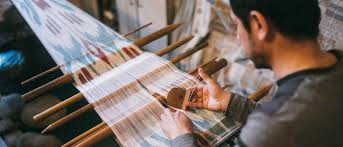
Indonesian textile art is known for its vibrant colors and intricate designs. One of the fascinating techniques used in this art form is the Indonesian technique in which yarns are resist dyed. This method involves using various materials to create patterns on the fabric, preventing the dye from penetrating certain areas. The result is a stunning interplay of colors and motifs that exemplify the rich cultural heritage of Indonesia. In this article, we will explore the history, process, and significance of this traditional technique, shedding light on the artistry and skill behind it.
The Origins of the Indonesian Technique in Which Yarns Are Resist Dyed
Indonesia has a long history of textile production, with evidence of weaving dating back thousands of years. The art of resist dyeing, also known as "batik," has been practiced in Indonesia for centuries. It is believed to have originated in the royal courts of Java, where it was considered a symbol of status and wealth.
The Process: Creating Intricate Patterns with Wax and Dye
To understand the Indonesian technique in which yarns are resist dyed, it's essential to delve into the process itself. This technique requires skilled artisans who meticulously apply wax to the fabric, creating patterns that will resist the dye. The wax is usually made from a combination of beeswax and paraffin, melted and applied using a tool called a "tjanting."
Once the wax is applied, the fabric is submerged in a dye bath. The areas covered in wax will remain untouched by the dye, while the rest of the fabric absorbs the vibrant colors. This process can be repeated multiple times, with different layers of wax and dyes, to achieve intricate and multicolored designs.
Tools and Materials Used in the Indonesian Technique
To master the Indonesian technique in which yarns are resist dyed, artisans rely on a range of tools and materials. Here are some of the essential elements used in the process:
1. Tjanting
The tjanting is a small copper container with a spout used to apply the hot wax onto the fabric. It comes in various sizes and shapes, allowing artisans to create different line thicknesses and patterns.
2. Canting
Similar to the tjanting, the canting is a tool used for applying wax to the fabric. However, it has a different design, with a wooden handle and a metal spout attached to it.
3. Wax
As mentioned earlier, a combination of beeswax and paraffin is typically used for the wax. Beeswax provides a sticky consistency, while paraffin helps to prevent cracking and flaking.
4. Natural Dyes
Artisans often use natural dyes derived from plants, roots, and barks to achieve vibrant and long-lasting colors. Some common natural dye sources include indigo, sappan wood, and morinda.
The Significance of the Indonesian Technique in Which Yarns Are Resist Dyed
The Indonesian technique in which yarns are resist dyed holds immense cultural and historical significance. It is deeply ingrained in the Indonesian identity and serves as a visual representation of the country's diverse traditions and folklore. Each pattern and motif tells a unique story, passed down through generations.
Furthermore, resist-dyed fabrics are not only valued for their aesthetic beauty but also for their practical uses. They are often incorporated into traditional clothing, home decor, and ceremonial objects. They play a vital role in various cultural ceremonies and celebrations, symbolizing prosperity, fertility, and protection.
FAQs
FAQ 1: What regions of Indonesia are known for the resist dyeing technique?
Answer: The Indonesian resist dyeing technique, also known as batik, is practiced throughout the archipelago. However, regions such as Java, Bali, and Sumatra are particularly renowned for their mastery of this art form.
FAQ 2: How long does it take to create a resist-dyed fabric?
Answer: The time required to create a resist-dyed fabric depends on the complexity of the design and the number of dyeing and waxing layers involved. It can take anywhere from a few days to several months to complete a single piece.
FAQ 3: Can the Indonesian technique in which yarns are resist dyed be used on different types of fabric?
Answer: Yes, the resist dyeing technique can be used on various types of fabrics, including cotton, silk, and rayon. However, the process may vary slightly depending on the fabric's characteristics and the desired outcome.
FAQ 4: Are there any modern adaptations of the resist dyeing technique?
Answer: Yes, while the traditional resist dyeing technique remains highly valued, there have been modern adaptations to cater to contemporary tastes. Some artisans experiment with different patterns, colors, and materials to create innovative designs that blend traditional and modern elements.
FAQ 5: How can one identify authentic Indonesian resist-dyed fabrics?
Answer: Authentic Indonesian resist-dyed fabrics exhibit specific characteristics, such as a handmade feel, intricate patterns, and a slight irregularity in the dye distribution. Additionally, traditional motifs and symbols associated with Indonesian culture are often present in these fabrics.
FAQ 6: Are there any efforts to preserve and promote the Indonesian resist dyeing technique?
Answer: Yes, various organizations and institutions in Indonesia are actively involved in preserving and promoting the Indonesian resist dyeing technique. They conduct workshops, exhibitions, and educational programs to ensure the continuity of this art form for future generations.
Conclusion
The Indonesian technique in which yarns are resist dyed is a testament to the country's rich cultural heritage and artistic prowess. Through a meticulous process of wax application and dyeing, skilled artisans create breathtaking patterns and motifs that encapsulate the essence of Indonesia. This ancient art form continues to inspire and captivate people worldwide, preserving the legacy of Indonesian textile traditions.
